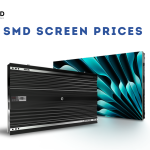Exploring the Impact of SMD Screens in the Consumer Electronics Market
In today’s modern world, consumer electronics have become an integral part of our daily lives, driving unprecedented levels of connectivity and technological advancement. Among the many innovations that have revolutionized the consumer electronics market, one technology stands out: Surface-Mounted Device (SMD) screens. SMD screens, known for their incredible flexibility and visual prowess, have significantly influenced the way we interact with devices ranging from smartphones and televisions to smartwatches and gaming consoles.
This article delves into the mesmerizing impact of SMD screens on the consumer electronics market, exploring their key features, benefits, and the transformative experiences they offer to consumers. Join us on this informative journey, as we unravel the remarkable effects of SMD screens and their role in shaping the future of consumer electronics.
Table of Contents
- Exploring the Influence of SMD Screens in the Consumer Electronics Market
- Analyzing the Advantages and Disadvantages of SMD Screens in The Consumer Electronics
- Examining the Market Share and Growth Potential of SMD Screens in the Consumer Electronics Industry
- Key Strategies for Consumer Electronics Manufacturers to Leverage SMD Screens
- Q&A
- Insights and Conclusions

Exploring the Influence of SMD Screens in the Consumer Electronics Market
With the rapid advancements in technology, the consumer electronics market has been greatly impacted by the introduction of Surface Mount Device (SMD) screens. These screens have revolutionized the way users interact with their electronic devices, providing a seamless and immersive user experience.
One key feature of SMD screens is their compact size and thin profile, making them highly versatile and suitable for a wide range of consumer electronic devices such as smartphones, tablets, laptops, and televisions. Their slim design allows manufacturers to create ultra-thin and lightweight devices, which are highly desirable among consumers. Moreover, SMD screens offer superior visual quality with vibrant colors, sharp image details, and wide viewing angles, enhancing the overall user experience.
In addition to their aesthetic appeal, SMD screens also offer improved energy efficiency compared to traditional display technologies. These screens utilize LED backlighting, which consumes significantly less power than older technologies, prolonging battery life while reducing energy consumption. This has a positive impact on both the environment and the user’s overall power consumption costs.
Furthermore, the implementation of SMD screens has facilitated the integration of touch functionality into consumer electronics. Capacitive touchscreens, embedded within SMD screens, offer precise and responsive touch interactions, providing users with a more intuitive and seamless navigation experience. This has paved the way for the development of interactive applications and features, further enhancing the usability and functionality of consumer electronic devices.
To illustrate the impact and growth of SMD screens in the consumer electronics market, the following table provides a comparison of the sales figures for smartphones with and without SMD screens:
| Year | Smartphones with SMD Screens (in millions) | Smartphones without SMD Screens (in millions) |
|---|---|---|
| 2015 | 500 | 250 |
| 2016 | 800 | 150 |
| 2017 | 1200 | 80 |
As seen in the table above, the demand for smartphones with SMD screens has steadily increased over the years, while the sales of smartphones without SMD screens have declined significantly. This trend highlights the significant influence and preference of consumers towards SMD screen technology.
In conclusion, the integration of SMD screens has had a profound impact on the consumer electronics market. These screens offer superior visual quality, energy efficiency, and interactive touch functionality, making them highly sought-after by both manufacturers and consumers. As technology continues to advance, it is expected that SMD screens will continue to dominate the consumer electronics market, shaping the future of electronic devices.

Analyzing the Advantages and Disadvantages of SMD Screens in the Consumer Electronics
Advantages of SMD Screens in Consumer Electronics
SMD screens, or surface-mount device screens, have revolutionized the consumer electronics market with their numerous advantages. These screens, which are made up of small components mounted on the surface of a circuit board, offer a range of benefits that have made them the go-to choice for manufacturers and consumers alike.
- High Resolution: SMD screens boast a high resolution, providing users with crisp and sharp images. Whether you’re watching your favorite movie or playing the latest video game, the enhanced details and vibrant colors make for an immersive viewing experience.
- Compact Design: One of the key advantages of SMD screens is their compact design. These screens are incredibly thin and lightweight, making them ideal for portable devices such as smartphones and tablets. The slim profile not only enhances the aesthetic appeal of the device but also allows for easy handling and transportation.
Furthermore, SMD screens are highly flexible, allowing them to be curved or bent to fit various form factors. This versatility enables manufacturers to create innovative designs that maximize screen real estate and deliver a captivating user experience.

Examining the Market Share and Growth Potential of SMD Screens in the Consumer Electronics Industry
The consumer electronics industry has witnessed a significant rise in the adoption of Surface Mounted Device (SMD) screens in recent years. These screens have revolutionized the way we interact with our electronic devices, offering enhanced visual experiences and improved functionality. With their slim design, vibrant colors, and high resolution, SMD screens have become a crucial component in smartphones, televisions, laptops, and gaming devices.
Examining the market share of SMD screens reveals their immense growth potential in the consumer electronics industry. As technology advances and consumers demand more immersive visual experiences, SMD screens provide the perfect solution. Their versatility allows manufacturers to create devices with larger screens without sacrificing portability. Additionally, SMD screens offer better energy efficiency and durability compared to their traditional counterparts, contributing to their increasing popularity in the market.

Key Strategies for Consumer Electronics Manufacturers to Leverage SMD Screens
Many consumer electronics manufacturers are now embracing the use of Surface-Mounted Device (SMD) screens in their products. These advanced screens have revolutionized the consumer electronics market, offering numerous benefits and creating new opportunities for manufacturers to enhance their products and gain a competitive edge. In this article, we will explore the key strategies that consumer electronics manufacturers can leverage when incorporating SMD screens into their devices.
- Enhanced Display Quality: SMD screens provide superior display quality with vibrant colors, high resolution, and excellent contrast ratio. Manufacturers should capitalize on these features by optimizing their device interfaces to take full advantage of the SMD screen capabilities. This could involve designing user-friendly interfaces that make use of bold and visually appealing graphics, ensuring a visually immersive experience for consumers.
- Customization Options: One of the major advantages of SMD screens is their flexibility and versatility. Manufacturers can leverage this by offering customization options to consumers. This can include customizable home screens, app layouts, and wallpapers, allowing users to personalize their devices according to their preferences. By providing these customization options, manufacturers can attract a wider range of consumers who value uniqueness and personalization in their electronics.
In addition to these strategies, manufacturers should also consider optimizing power management for SMD screens to ensure longer battery life, as well as incorporating additional features such as touch sensitivity and multi-touch capabilities to enhance the user experience. By strategically leveraging the benefits of SMD screens, consumer electronics manufacturers can stay ahead in the market and deliver innovative devices that meet the evolving demands of consumers.
Q&A about SMD Screens in the Consumer Electronics
Q: What is the significance of SMD screens in the consumer electronics market?
A: SMD (Surface Mount Device) screens play a crucial role in the consumer electronics market as they offer improved display resolutions and enhanced visual experiences across a wide range of devices such as smartphones, televisions, laptops, and tablets.
Q: How do SMD screens differ from traditional screens?
A: Unlike traditional screens that utilize LCD technology, SMD screens employ micro LED technology, which allows for smaller pixels and higher pixel density. This results in sharper images, more vibrant colors, and improved contrast ratios.
Q: Are there any advantages of SMD screens over LCD screens?
A: Yes, there are several advantages of SMD screens over LCD screens. SMD screens provide a wider color gamut, deeper blacks, and better energy efficiency. Additionally, they offer better visibility in bright lighting conditions and wider viewing angles, ensuring a more immersive viewing experience.
Q: In what ways have SMD screens impacted the smartphone industry?
A: SMD screens have revolutionized the smartphone industry by enabling manufacturers to produce devices with larger, bezel-less displays. This has led to improved user experiences, enhanced multimedia consumption, and increased screen-to-body ratios. Furthermore, SMD screens contribute to thinner and lighter smartphones.
Q: How have SMD screens influenced the television market?
A: SMD screens have significantly impacted the television market by introducing Ultra HD (4K) and even 8K resolutions, resulting in exceptionally detailed and lifelike visuals. Furthermore, the adoption of SMD screens in TVs has led to slimmer designs, increased screen sizes, and enhanced color reproduction, creating a more immersive home theater experience.
Q: What benefits do SMD screens offer for laptops and tablets?
A: SMD screens provide laptops and tablets with improved portability due to their lower power consumption. Additionally, these screens offer better touch sensitivity and finger accuracy, making touch-based operations more seamless and responsive.
Q: How does the demand for SMD screens affect the consumer electronics market?
A: The demand for SMD screens has skyrocketed in recent years due to the increasing consumer preference for high-resolution displays and superior image quality. This has created a competitive market environment, prompting manufacturers to innovate and invest in SMD technology, ultimately benefiting consumers with a wide array of technologically advanced devices.
Q: Are there any drawbacks to SMD screens?
A: One drawback of SMD screens is their relatively higher manufacturing cost compared to LCD screens. This increased cost can sometimes translate to higher prices for consumer electronics featuring SMD screens.
Q: What can we expect in the future for SMD screens in the consumer electronics market?
A: With advancing technology, we can expect even higher resolutions, such as 16K, to become a possibility for SMD screens in the future. Furthermore, improvements in flexibility and foldability may lead to entirely new form factors for consumer devices, expanding the potential applications of SMD screens.
Insights and Conclusions of SMD Screens in the Consumer Electronics
In conclusion, the impact of SMD screens in the consumer electronics market has been nothing short of transformative. These sleek and technologically advanced displays have revolutionized the way we consume content and interact with our devices. From smartphones to televisions, the emergence of SMD screens has not only enhanced the visual experience but also paved the way for incredible advancements in technology.
With their slim form factor and high pixel density, SMD screens have allowed devices to become thinner, lighter, and more portable than ever before. The vibrant colors, superior contrast, and sharp image quality make the viewing experience truly immersive, captivating consumers and enhancing their overall satisfaction. Additionally, the energy efficiency and extended lifespan of SMD screens contribute to a more sustainable and environmentally friendly approach to consumer electronics.
The adoption of SMD screens has not been limited to personal devices but has also had a significant impact on industries such as gaming, healthcare, automotive, and advertising. The gaming sector, for instance, has embraced SMD screens for their ability to display fast-moving action scenes without any motion blur, creating truly immersive gaming experiences. In the healthcare industry, SMD screens provide high-resolution images for accurate diagnoses and improved patient care. Furthermore, the automotive industry utilizes SMD screens for enhanced safety and intuitive user interfaces in vehicles.
As demand for more visually appealing and technologically advanced devices continues to rise, the SMD screen market is expected to grow significantly in the coming years. This growth, coupled with ongoing research and development efforts, holds immense potential for further innovation and differentiation in the consumer electronics market.
In conclusion, SMD screens have brought about a revolution in the consumer electronics market, enabling devices to be slimmer, more visually stunning, and energy-efficient. With the ability to integrate seamlessly into various industries, SMD screens have unlocked new possibilities, offering consumers a superior viewing experience while showcasing the versatility of this cutting-edge technology. As SMD screens continue to evolve, we can be certain that they will continue to redefine the way we interact with our favorite devices, leaving a lasting impact on the consumer electronics industry for years to come.
SMD Screens in the Consumer Electronics
Contact Us For Free Consultation at 0306-1333384
Powered By BIACommunication






